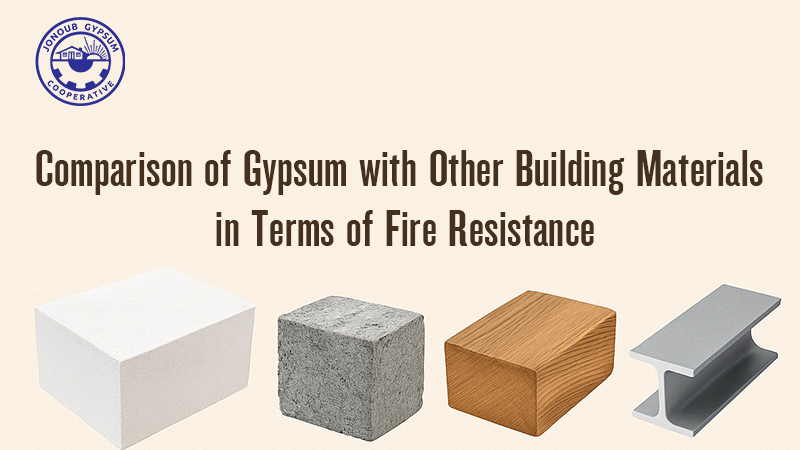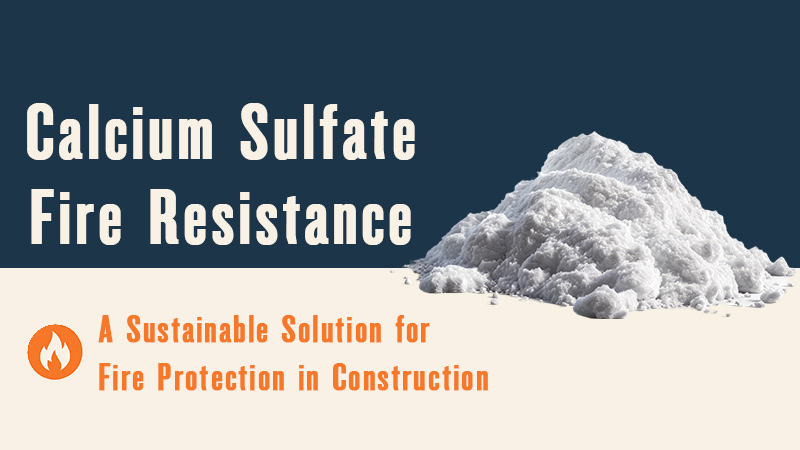
Comparison of Gypsum with Other Materials
In the world of construction, safety is just as important as aesthetics and strength. Among the many safety concerns, fire resistance stands out as one of the most critical factors when choosing building materials. A building that performs well structurally but fails to resist fire can pose a serious threat to both lives and property.
One material that often flies under the radar in discussions about fire safety is gypsum. Known primarily for its use in plaster and drywall, gypsum possesses unique thermal characteristics that make it naturally fire-resistant. But how does it compare to other common building materials like concrete, wood, and steel? In this article, we’ll explore the fire-resistant properties of gypsum and see how it stacks up against its construction counterparts.
Why Is Fire Resistance Important in Construction?
When a fire breaks out in a building, every second counts. The more fire-resistant the materials are, the more time residents and emergency responders have to act. Fire-resistant materials help prevent the rapid spread of flames, reduce heat transfer, and protect the structural integrity of the building — all of which are essential for buying time and saving lives.
Therefore, selecting the right materials with verified fire performance ratings is not only a design choice but also a legal and ethical responsibility.
The Science Behind Gypsum’s Fire Resistance
Gypsum is a mineral composed of calcium sulfate dihydrate (CaSO₄·2H₂O). What sets it apart is the chemically bound water molecules within its structure. When exposed to heat, gypsum undergoes a process called endothermic dehydration, in which it releases water vapor while absorbing heat from the environment.
This reaction serves two essential functions:
- Slows down heat transmission through the material.
- Reduces flame propagation by releasing non-combustible steam.
After this water has been driven off, the gypsum forms a solid, heat-resistant layer of anhydrous calcium sulfate. This thermal barrier helps delay further heat penetration, offering extended protection even under intense fire exposure.
Gypsum vs. Other Building Materials
To better understand gypsum’s performance, it’s useful to compare it with other widely used construction materials in terms of how they behave in fire conditions.
_ Concrete, for example, is inherently non-combustible and generally performs well under heat. However, when exposed to high temperatures for a prolonged time, concrete can crack, spall, and lose its load-bearing capacity, especially if it contains moisture or steel reinforcement.
_ Wood, on the other hand, is a combustible material. While some engineered wood products can offer moderate fire performance, untreated wood can ignite quickly and burn intensely, often releasing toxic smoke. Its use in fire-prone zones is typically limited or heavily regulated.
_ Steel does not burn, but it conducts heat rapidly and loses 50% of its strength at just 550°C (1022°F). Without insulation or protective coatings, steel frames can warp, buckle, or collapse in a fire.
Compared to these materials, gypsum stands out not just because it doesn’t burn, but because it actively slows down the spread of fire through moisture release and thermal shielding. In fact, fire-rated gypsum boards can offer up to 2 hours of resistance, making them ideal for partitions, ceilings, and fire separation systems.
Practical Applications of Fire-Resistant Gypsum

One of the most common uses of gypsum in fire protection is in the form of gypsum board (also known as drywall or plasterboard). Specialized versions, such as Type X or Type C gypsum board, are reinforced with glass fibers and formulated for fire-resistance. These are widely used in commercial and residential buildings to create fire-rated walls and ceilings.
In addition to drywall systems, gypsum is also used in spray-applied fire-resistive materials (SFRMs) for steel structures, helping prevent collapse during fires. Its compatibility with other materials makes it a flexible solution for enhancing overall fire safety in modern buildings.
Environmental and Economic Advantages
Fire protection is only one side of the story. Gypsum also stands out for being non-toxic, widely available, and recyclable. Unlike some synthetic fireproofing materials that emit harmful gases when burned, gypsum releases only water vapor. It complies with green building standards such as LEED and BREEAM, making it an excellent choice for sustainable construction.
Economically, gypsum is cost-effective and easy to apply, requiring less labor and specialized tools compared to installing heavy fireproof coatings or elaborate insulation systems.
Final Thoughts: Why Choose Gypsum?
When choosing construction materials, it’s easy to focus on strength, aesthetics, or cost. But when fire safety is a top priority — especially in multi-story, commercial, or high-occupancy buildings — the role of materials like gypsum becomes critically important.
Gypsum’s natural fire resistance, low cost, ease of installation, and environmental benefits make it one of the most versatile and reliable materials available today. Whether used on its own or in combination with other fire-rated systems, gypsum offers a layer of safety that could make all the difference during a fire emergency.






